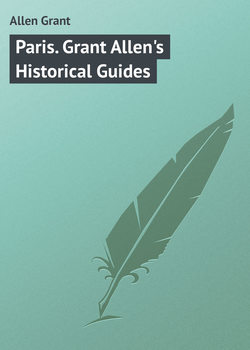Paris. Grant Allen's Historical Guides

Реклама. ООО «ЛитРес», ИНН: 7719571260.
Оглавление
Allen Grant. Paris. Grant Allen's Historical Guides
INTRODUCTION
HOW TO USE THESE GUIDE-BOOKS
ORIGINS OF PARIS
I. THE ÎLE DE LA CITÉ
A. THE PALAIS DE JUSTICE AND THE SAINTE CHAPELLE
B. NOTRE-DAME
II. THE LEFT OR SOUTH BANK
A. THE ROMAN PALACE AND THE. MUSÉE DE CLUNY
B. THE HILL OF STE. GENEVIÈVE (Panthéon, St. Étienne-du-Mont.)
III. RENAISSANCE PARIS (THE LOUVRE)
A. THE FABRIC
B. THE COLLECTIONS
I. PAINTINGS
II. SCULPTURE
1. ANTIQUE SCULPTURE
2. RENAISSANCE SCULPTURE
3. MODERN SCULPTURE
III. THE SMALLER COLLECTIONS
IV. THE NORTH BANK (RIVE DROITE)
A. THE CORE OF THE RIGHT BANK
B. THE OUTER RING OF LOUIS XIV
V. THE FAUBOURG ST. GERMAIN (Luxembourg, etc.)
VI. ST. DENIS
VII. THE OUTER RING, ETC
Отрывок из книги
THE portions of this book intended to be read at leisure at home, before proceeding to explore each town or monument, are enclosed in brackets [thus]. The portion relating to each principal object should be quietly read and digested before a visit, and referred to again afterwards. The portion to be read on the spot is made as brief as possible, and is printed in large legible type, so as to be easily read in the dim light of churches, chapels, and galleries. The key-note words are printed in bold type, to catch the eye. Where objects are numbered, the numbers used are always those of the latest official catalogues.
Baedeker’s Guides are so printed that each principal portion can be detached entire from the volume. The traveller who uses Baedeker is advised to carry in his pocket one such portion, referring to the place he is then visiting, together with the plan of the town, while carrying this book in his hand. These Guides do not profess to supply practical information.
.....
Room VII (beyond the corridor, a modern covered courtyard). —Tapestries and textile fabrics, interesting chiefly to ladies. On Wall A, and others, Flemish tapestry, representing the History of Bathsheba, much admired and very ugly; compare it with the tapestry of the Lady and the Unicorn, to be visited later in Room III, upstairs, contrasting them as models of what such work should and should not be. Wall B, admirable Renaissance relief of the Cardinal Virtues. Above it, a good Madonna, and figures of Grammar and Astronomy. Wall C, Caryatid of inferior art, French, 16th century. **(448), Admirable group of the Three Fates, attributed to Germain Pilon, the great French sculptor of the 16th century, whom we shall meet again at the Louvre – a fine specimen of the plastic art of the Renaissance, said to represent Diane de Poitiers and her daughters. Below **(447), exquisite Renaissance bas-relief of the huntress Diana, of the School of Jean Goujon, again in allusion to Diane de Poitiers. (478) Good mask of the same epoch. (251) Virgin and Child, meretricious; in the decadent style of the 16th century; very French in type, foreshadowing the Louis XV spirit – the Madonna resembles a little-reputable court lady. Wall D (463, etc.), Judgment of Solomon, Solomon and the Queen of Sheba, Annunciation, and other reliefs in the florid and least pleasing French style of the 16th and 17th centuries. Table by the doorway **(449), exquisite small marble statue of the Deserted Ariadne (perhaps Diane de Poitiers), in the best Renaissance manner, probably by Germain Pilon: found in the Loire, near Diane’s château of Chaumont. Beside it, three sleeping Venuses, one of which is also said to be Diane de Poitiers, the goddess of the Renaissance in Paris. L of doorway (457), singular marble relief of Christ and the Magdalen after the Resurrection (Noli me tangere); the Saviour strangely represented (as often) in a gardener’s hat and with a spade; in the background, angels by the empty sepulchre; Flemish, florid style of the 16th century. Beside it (467 and 468), two exquisite Renaissance reliefs of Venus. In front of it, on the table *(479), Entombment, with the body of Christ placed in the sarcophagus by Joseph of Arimathea and Nicodemus – portraits, I think, of the donors.
Room VIII – Textile fabrics and ecclesiastical robes. Wall B, L of door (487), pretty but meretricious little group of Venus and Cupids, with grapes, French style of the 17th century; the national taste still more distinctly showing itself. R of door (459), in two separate figures, a quaint Annunciation – French, 16th century, frankly anachronistic. Close by (464), the Judgment of Solomon, same school and period. Above (563), clever small alabaster group of the Rape of the Sabines, after Giovanni da Bologna. These all stand on a handsome French carved chest of the 16th century. Wall C, greatly worn altar-relief of the Adoration of the Magi, from the chapel of the Château d’Anet, French Renaissance, 16th century. Above it (446), Mary Magdalen, kneeling, with long hair and the alabaster box of ointment – her symbol in art – 15th century, curious. At the back, gilt and painted figures of the Holy Trinity, from the demolished church of St. Marcel at Paris, 17th century. Similar representations of the Trinity, showing the three Persons thus, are common in Italian art. Further on (493), good figure of a shepherd, French, 16th century. Wall A (266), curious altar back, Herod ordering the Massacre of the Innocents. (267) St. Eustace crossing the river (see Room VI) with the lion and the wolf seizing his children. A very different treatment from the previous one. (291) A lintel of a chimney, Flemish, dated 1555; centre, a river-god; L and R, pelican and eagle; between the figures, Faith, Hope, Charity and Prudence. (273) Madonna and Child (Notre-Dame de l’Espérance, throned on an anchor). On the wall, far L, interesting piece of French 14th century tapestry, with a legend of St. Marcel and St. John Evangelist, most naïvely represented.
.....